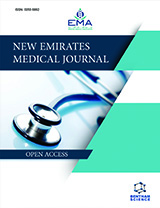Abstract
Background: Rhinoliths are calcified or mineralized concretions that are deposited around a nucleus and are usually unilateral. They are rare with an estimated incidence of 1:10000 of all ENT outpatient cases. This may be an underestimation as many cases remain asymptomatic since the process may take years to develop.
Case Report: We report a case of unilateral nasal obstruction since childhood in an adult male where the diagnosis remained obscured until thorough assessment was done. According to the anterior rhinoscopic and nasoendoscopic examination, there was an irregular bony mass occupying the left nasal cavity from the floor to the middle meatus. The diagnosis of rhinolith was confirmed by nasoendoscopy and non-contrast CT (NCCT) scan, and it was removed piecemeal from the nose.
Conclusion: This case underlines the importance of a detailed clinical and endoscopic examination of the nose in adult cases with unilateral nasal obstruction. It also highlights the potential for misdiagnosis of such cases at the hands of general practitioners or physicians and the importance of early referral to an otolaryngologist in case of treatment failure by established protocols.
Keywords: Rhinolith, Nucleus, Exogenous, Endogenous, Encrustations, Unilateral, Nasal obstruction, Halitosis, Cacosmia, Nasoendoscopy, Surgical removal.
New Emirates Medical Journal
Title:Case Report of a Large Rhinolith Cast – A Frequently Missed Diagnosis
Volume: 2
Author(s): Irshad Mohiuddin, Mayank Vats and Azmina Hussain*
Affiliation:
- Public Health Scientist, Medstar Healthcare LLC Dubai, Dubai,United Arab Emirates
Keywords: Rhinolith, Nucleus, Exogenous, Endogenous, Encrustations, Unilateral, Nasal obstruction, Halitosis, Cacosmia, Nasoendoscopy, Surgical removal.
Abstract: Background: Rhinoliths are calcified or mineralized concretions that are deposited around a nucleus and are usually unilateral. They are rare with an estimated incidence of 1:10000 of all ENT outpatient cases. This may be an underestimation as many cases remain asymptomatic since the process may take years to develop.
Case Report: We report a case of unilateral nasal obstruction since childhood in an adult male where the diagnosis remained obscured until thorough assessment was done. According to the anterior rhinoscopic and nasoendoscopic examination, there was an irregular bony mass occupying the left nasal cavity from the floor to the middle meatus. The diagnosis of rhinolith was confirmed by nasoendoscopy and non-contrast CT (NCCT) scan, and it was removed piecemeal from the nose.
Conclusion: This case underlines the importance of a detailed clinical and endoscopic examination of the nose in adult cases with unilateral nasal obstruction. It also highlights the potential for misdiagnosis of such cases at the hands of general practitioners or physicians and the importance of early referral to an otolaryngologist in case of treatment failure by established protocols.
Export Options
About this article
Cite this article as:
Mohiuddin Irshad, Vats Mayank and Hussain Azmina *, Case Report of a Large Rhinolith Cast – A Frequently Missed Diagnosis, New Emirates Medical Journal 2021; 2 (2) . https://dx.doi.org/10.2174/0250688202999210429111307
| DOI https://dx.doi.org/10.2174/0250688202999210429111307 |
Print ISSN 0250-6882 |
| Publisher Name Bentham Science Publisher |
Online ISSN 0250-6882 |
 1
1
- Author Guidelines
- Graphical Abstracts
- Fabricating and Stating False Information
- Research Misconduct
- Post Publication Discussions and Corrections
- Publishing Ethics and Rectitude
- Increase Visibility of Your Article
- Archiving Policies
- Peer Review Workflow
- Order Your Article Before Print
- Promote Your Article
- Manuscript Transfer Facility
- Editorial Policies
- Allegations from Whistleblowers
Related Articles
-
Targeting Telomerase for Cancer Therapy
Current Cancer Therapy Reviews The Role of MDCT in Craniocervical Junction Pathologies: Pictorial Review
Current Medical Imaging Preferentially Expressed Antigen in Melanoma (PRAME) and the PRAME Family of Leucine-Rich Repeat Proteins
Current Cancer Drug Targets Ectopic Thyroid Gland: Description of a Case and Review of the Literature
Endocrine, Metabolic & Immune Disorders - Drug Targets Therapeutic Approach of Primary Bone Tumours by Bisphosphonates
Current Pharmaceutical Design Molecular Pathology of Sarcomas
Reviews on Recent Clinical Trials MiRNA153 Reduces Effects of Chemotherapeutic Agents or Small Molecular Kinase Inhibitor in HCC Cells
Current Cancer Drug Targets Understanding Mesenchymal Cancer: The Liposarcoma-Associated t(12;16) (q13;;p11) Chromosomal Translocation as a Model
Current Genomics Enasidenib: First Mutant IDH2 Inhibitor for the Treatment of Refractory and Relapsed Acute Myeloid Leukemia
Anti-Cancer Agents in Medicinal Chemistry Targeting CSC-Related miRNAs for Cancer Therapy by Natural Agents
Current Drug Targets Emerging Therapies Targeting Tumor Vasculature in Multiple Myeloma and other Hematologic and Solid Malignancies
Current Cancer Drug Targets Irreversible LSD1 Inhibitors: Application of Tranylcypromine and Its Derivatives in Cancer Treatment
Current Topics in Medicinal Chemistry Imaging Features of Primary Tumors of the Hand
Current Medical Imaging Complications of Muscle Hematomas in Hemophilia
Cardiovascular & Hematological Disorders-Drug Targets The Chick Embryo Chorioallantoic Membrane as a Model for in vivo Research on Anti-Angiogenesis
Current Pharmaceutical Biotechnology The Medicinal Chemistry of Theragnostics, Multimodality Imaging and Applications of Nanotechnology in Cancer
Current Topics in Medicinal Chemistry Flavonoids as Multi-Target Compounds in Drug Discovery
Mini-Reviews in Organic Chemistry Ewing’s Sarcoma Cancer Stem Cell Targeted Therapy
Current Stem Cell Research & Therapy Cyclodepsipeptides - Potential Drugs and Lead Compounds in the Drug Development Process
Current Medicinal Chemistry Inhibition of Hedgehog/Gli Signaling by Botanicals: A Review of Compounds with Potential Hedgehog Pathway Inhibitory Activities
Current Cancer Drug Targets




























